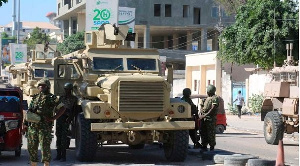Africa News of Sunday, 6 August 2023
Source: thecitizen.co.tz
AU mission sticks to Somalia exit plan as Shabaab hit Kenya
The African Union Transition Mission in Somalia (Atmis) is keeping its exit plan, preparing a pool of another 3,000 troops to leave the country as part of a long-term rebuilding plan for Mogadishu.
But that may mean deeper security challenges for neighboring Kenya, which has lately been suffering from attacks from the militant group Al Shabaab.
This week, Atmis chiefs said the latest drawdown of troops will be done by the end of September. And the African Union and the United Nations missions in Somalia reaffirmed their support for Somalia's state-building to fill the gap. Yet, the programme directly affects Kenya which may be banking on adequate stability in Somalia to manage its own security.
Mohamed el-Amine Souef, head of Atmis, and Aisa Kirabo Kacyira, head of the UN Support Office in Somalia (Unsos) visited Kismayu, a town in southern Somalia, where they met UN and Atmis personnel to discuss the ongoing offensive against the Shabaab, security and political issues.
And Souef urged the personnel to continue to provide specialized training and knowledge transfer to Somalia's public servants to help increase the number of skilled personnel in various sectors.
“Somalia has made great progress, and that progress is due to the collaborative work with Atmis and the UN in terms of improving security and fighting against Al Shabaab militants. Today, people in Somalia can live safely," he said in a joint statement issued in Mogadishu.
"I would like to remind you that we are here for a good cause to support the people of Somalia. Whatever we do, we should put their interests first," Souef added in his address to the mission's staff based in Kismayu.
The visit by the two officials came at a time when the Atmis and its partners are preparing to conduct a joint technical assessment on phase one of the Atmis troop withdrawal, which was concluded in June. The findings will inform the second phase which requires the Atmis to withdraw another 3,000 troops by the end of September. During phase one, the Atmis withdrew 2,000 troops from Somalia and handed over six military bases to the Somali security forces.
The phased withdrawal of the African peacekeepers in Somalia is happening as Kenya faces more attacks in the northeastern and coastal regions.
Lamu County has experienced the most attacks since June, as Al Shabaab is employing improvised explosive devices, attacks of villages, and stationing militants by the roadsides in northern and coastal regions of Kenya that ambush public and police vehicles.
On August 2, 60 Al Shabaab militants were killed by the security forces after trying to attack four fleets of buses at the Lamu-Tana River counties intersection. Two people died while 10 others, including a ward representative, James Njaaga, were injured after Al Shabaab laid an ambush at Mwembeni area on the Lamu-Witu-Garsen road on August 1.
Kenya’s Interior Cabinet Secretary Prof Kithure Kindiki said that unknown people were missing. The militants using rocket-propelled grenades unsuccessfully attacked an armored personnel carrier belonging to the Special Operations Group.
These attacks came only a few days after Kenya’s President William Ruto and Prof Kindiki toured Lamu and assured residents of their security. Prof Kindiki said that despite Lamu having witnessed insecurity, the government is working hard to ensure that residents are protected from future attacks.
Three weeks earlier, the militants attacked the Salama area where five people were killed and six houses burned. These increased Al Shabaab activities in Lamu have adversely affected economic activities such as tourism, fishing, and agriculture. In the northeastern counties of Mandera, Wajir, and Garissa, non-locals are particularly at risk of attack, In the last two months, 37 teachers and 30 security personnel have been killed in the northeastern region.
Prof Kindiki said Kenya has intelligence of the increased presence of terror elements in the northeastern region and that the government has decided to withdraw non-local teachers from various areas of residence and put them in central safe areas where they are guarded and escorted to and from work.
It is now a concern that the drawdown will increase insecurity in the entire region as Al Shabaab gets emboldened by the inability of the Somalia security forces to hold on to liberated areas.
Due to these concerns, Kenya, Ethiopia, and Djibouti—three of the five troop-producing countries that are directly affected by the activities of Al Shabaab—have offered to retain a certain number of troops in Somalia even if Atmis entirely withdraws by the end of 2024.
Governor Khalif expressed concerns during a forum by four countries; Mandera, Wajir; Garissa, and Lamu that have been attacked by Al Shabaab in recent times. The attacks mainly occurred in June when Kenya’s national police force said that some 20 people were killed in Lamu within one week.
Gen Peter Kimani Muteti, the Atmis Deputy Force Commander in charge of Support and Logistics, said that the peacekeepers had fulfilled their key components of the mandate including degrading Al Shabaab, protecting civilians, ensuring that we are giving access to and escorts to humanitarian assistance, mentoring Somali Security Forces (SSF), and not forgetting issues of supporting stabilization.
“We must consistently ensure that, whether jointly or individually as Atmis, we continue to deliver the mandate in the manner in which it is provided,” said Gen Muteti. Atmis withdrew 2000 soldiers from Somalia at the end of June and a further 3,000 will be withdrawn in September.
Entertainment










